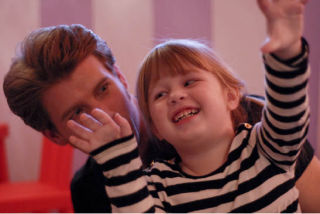In her pretty pink room, the 4-year-old quickly ran her hands along a bookshelf, feeling for her toy tool box.
With her flying blonde pigtails, Holly Connor appears like just another toddler ready to bust into preschool.
Yet little Holly has a unique set of challenges.
“She’s the only blind child who lives here, in this [school] district,” said Katie Connor, Holly’s mother.
Holly has Optic Nerve Hypoplasia (ONH), which means that her optic nerve never fully developed. Western doctors offered little hope that Holly would ever see.
Little research has been done on ONH, even though it is the leading cause of childhood blindness in the United States.
“Most people don’t even know about this condition,” her mother said.
So as soon as Katie and her husband, Dan Connor, heard about an experimental stem-cell treatment in Bangkok, they took hope and began fundraising the $75,000 needed for the five-week trip.
Despite medical opposition, families from around the world have celebrated the treatment’s success. This has the Connors optimisitc.
Yet the therapy has not been scientifically proven to work, and the Food and Drug Administration is far from approving it to be safe for human testing.
The treatment uses umbilical-cord stem cells and not the controversial embryonic stem cells. But for doctors the debate involves both ethics and cost.
“I think it’s unethical to charge people many thousands of dollars for a treatment that costs about $1,000, that has no proven improvement and has risks,” said Mark Borchert, a leading U.S. ONH researcher from the Vision Center at Children’s Hospital in Los Angeles.
Based on researchers’ current understanding of stem cells, it does not make sense that the treatment would work, Borchert said. “No one has been able to get it to work on animals, and believe me, it’s been tried.”
A Developmental Disorder
Holly’s little round fingers stretched out across the family’s upright piano. Standing up, her head reaches just above the keys, and with the ease and drama of an ordinary conversation she plays a tune on her mind.
“She started playing at six months. We helped her find the keys and notes, but [she] now does it all on her own,” Katie said. “She plays everything from Bach, Mozart, to musicals like ‘Seussical’ or simple songs like ‘Twinkle Twinkle.’”
Savantism — having a prodigious talent — is often associated with autism, which is one developmental disorder common for children with ONH. Holly has musical abilities, but she also displays all the characteristics of autism, from extreme food restrictions to needing everything to come in even numbers.
She struggles being in public places, and her fits often draw stares. But at home she is a joy, doing somersaults off furniture and twirling much longer than most children could stomach.
“This treatment also helps with autism,” Katie said, explaining that the stem cells work universally on developmental problems. The idea is that they can attach to parts of the body that are not fully developed and then these parts grow into the right cells.
The developmental problems that people with ONH have vary widely in degree and type, and parents often say that they are far worse than blindness, Borchert said. “Vision problems should be the least of their concerns.”
Going to Asia
So far, the Connors have raised about $45,000 of the $75,000 for the stem-cell therapy. They have organized events from community garage sales to a concert fundraiser, in hopes to have the money in April for a summer trip.
While in Bangkok, Holly is expected to receive seven injections over the five-week period. The treatment can be administered intravenously or directly into the spinal cord.
While Beike Biotech, the Chinese-based company offering the treatments, said the spinal injections are more effective, however they risk serious infection with diseases such as meningitis and multiple sclerosis.
None of Beike’s patients have been infected through spinal injections, a representative said.
Yet Borchert has seen the process cause serious injury.
“I know there is a risk every time you stick a needle in the spinal cord,” he said.
Beike’s treatments are even riskier, as the injection of stem cells also exposes the brain to antigens that it otherwise wouldn’t have encountered, he said. “You cannot predict the long-term outcomes of this. It can cause all kinds of disorders,” Borchert said.
Sometimes it can take years for disorders to develop, he said. Beike does not heavily monitor its outcomes, and it does not use unbiased onlookers.
“To say there is no risk is absurd, just because they don’t know,” he said.
The Connors still have time to decide if Holly is going to receive spinal injections, but all the patients start by receiving the drug intravenously.
The worst-case scenario is only minor improvement, Katie said. The hope is that Holly will be able to recognize shapes and colors at a distance.
“They may thoroughly believe that this is working, but they have no way of knowing it, because they don’t monitor the outcomes,” Borchert said, adding that most children improve on their own. “They need to be monitored carefully and the vision can be optimized, but there is not any magic treatment.”
Yet Holly’s parents are determined to go through with the proceedure.
“There are so many unknowns, and I’ve been living it for four years,” Katie said. “All these kids are improving. How can they not take that into [account]?”
Katie used social-networking Web sites to find families with ONH children, and after presenting her own research, she received support from Holly’s pediatrician to go forward with the treatment. It was a great boost of confidence, offering a glimmer of hope.


